The Culture of Science
The Nature of Scientific Knowledge
Did you know?
Did you know that it was not Magellan, Columbus, or even Copernicus who proposed that the world was round? Rather, 2000 years before these Europeans, Greek philosophers referred to the earth as a sphere. An accumulation of evidence over the centuries confirmed that the Earth was round long before explorers sailed around the world.
It seems preposterous to us today that people once thought that the Earth was flat. Who could have possibly thought of our planet as a giant disk with the stars and heavens above, and boulders, tree roots, and other things below? But this was the dominant view of Earth in much of the world before the 2nd century BCE, though the details differed from culture to culture. And it was not explorers who sailed around the world that finally laid the idea to rest, but an accumulation of evidence long before this.
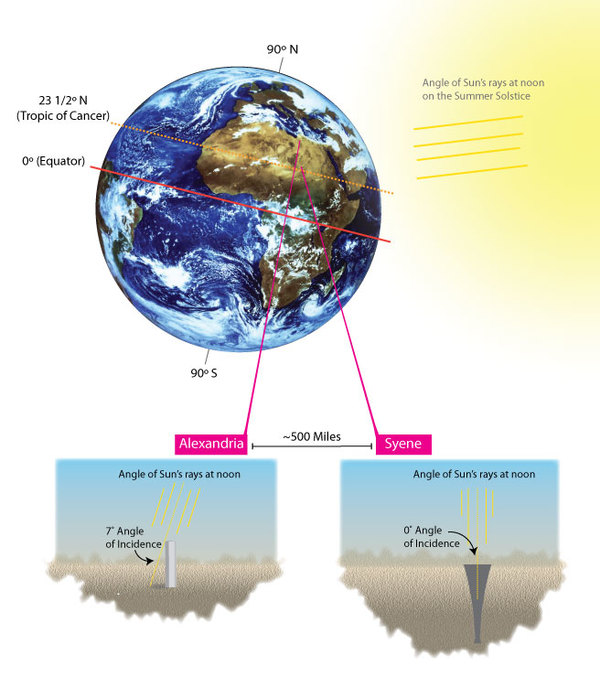
Greek philosophers referred to a spherical Earth as early as the 6th century BCE. They observed that the moon appeared to be a sphere and therefore inferred that Earth might also be spherical. Two hundred years later, in the 4th century BCE, the Greek philosopher Aristotle observed that the shadow of the Earth on the Moon during a lunar eclipse is always curved, thus providing some of the first evidence that Earth is spherical. In the 3rd century BCE, the mathematician Eratosthenes observed that at noon on the summer solstice in the ancient Egyptian city of Syene, the sun was directly overhead as objects did not cast a shadow. Eratosthenes was from Alexandria, Egypt, some 500 miles to the north, and he knew that a tall tower cast a shadow in that city at the same time on the summer solstice. Using these observations and measurements of shadow length and distance, he inferred that the surface of the Earth is curved and he calculated a remarkably accurate estimate of the circumference of the planet (Figure 1). Some years later, the Greek geographer Strabo added to this evidence when he observed that sailors saw distant objects move downward on the horizon and disappear as they sailed away from them. He proposed that this was because Earth was curved and those sailors were not simply moving further away from the objects but also curving around the planet as they sailed.

Aristotle, Eratosthenes, and Strabo didn't call themselves scientists, yet they were using the process of science by making observations and providing explanations for those observations. Thus, we knew that Earth was a sphere long before Ferdinand Magellan's men sailed all the way around it in 1522 or before Apollo 8 astronauts sent back pictures of Earth from space in 1968 (Figure 2), documenting its spherical shape. In fact, those astronauts had to be absolutely confident that the Earth was a rotating sphere, orbiting the Sun, or they would never have been able to get into orbit. It is the nature of science and scientific knowledge that gave them that confidence, and understanding the difference between scientific knowledge and other types of knowledge is critical to understanding science itself.
What is science?
Science consists of two things: a body of knowledge and the process by which that knowledge is produced. This second component of science provides us with a way of thinking and knowing about the world. Commonly, we only see the "body of knowledge" component of science. We are presented with scientific concepts in statement form – Earth is round, electrons are negatively charged, our genetic code is contained in our DNA, the universe is 13.7 billion years old – with little background about the process that led to that knowledge and why we can trust it. But there are a number of things that distinguish the scientific process and give us confidence in the knowledge produced through it.
So then, what is the scientific process? The scientific process is a way of building knowledge and making predictions about the world in such a way that they are testable. The question of whether Earth is flat or round could be put to the test, it could be studied through multiple lines of research, and the evidence evaluated to determine whether it supported a round or flat planet. Different scientific disciplines typically use different methods and approaches to investigate the natural world, but testing lies at the core of scientific inquiry for all scientists.
As scientists analyze and interpret their data (see our Data Analysis and Interpretation module), they generate hypotheses, theories, or laws (see our Theories, Hypotheses, and Laws module), which help explain their results and place them in context of the larger body of scientific knowledge. These different kinds of explanations are tested by scientists through additional experiments, observations, modeling, and theoretical studies. Thus, the body of scientific knowledge builds on previous ideas and is constantly growing. It is deliberately shared with colleagues through the process of peer review (see our Peer Review module), where scientists comment on each other's work, and then through publication in the scientific literature (see our Utilizing the Scientific Literature module), where it can be evaluated and integrated into the body of scientific knowledge by the larger community. And this is not the end: One of the hallmarks of scientific knowledge is that it is subject to change, as new data are collected and reinterpretations of existing data are made. Major theories, which are supported by multiple lines of evidence, are rarely completely changed, but new data and tested explanations add nuance and detail.
A scientific way of thinking is something that anyone can use, at any time, whether or not they are in the process of developing new knowledge and explanations. Thinking scientifically involves asking questions that can be answered analytically by collecting data or creating a model and then testing one's ideas. A scientific way of thinking inherently includes creativity in approaching explanations while staying within the confines of the data. Thinking scientifically does not mean rejecting your culture and background, but recognizing the role that they play in your way of thinking. While testable explanations are a critical component of thinking scientifically, there are other valid ways of thinking about the world around us that do not always yield testable explanations. These different ways of thinking are complementary – not in competition – as they address different aspects of the human experience.
It's easy to be confident in the scientific process and our knowledge when we can provide irrefutable evidence, as we were able to do by orbiting around the Earth in a spaceship and taking pictures of an obviously round planet. But most scientific investigations do not lead to results that are so easily supported, and yet we still rely on and trust the knowledge produced through the process of science. Why do we trust it? Because it works. Science has a long history of creating knowledge that is useful and that gives us more insight into our surroundings. Take one of the statements above: The universe is 13.7 billion years old. Why should we have confidence in this statement?
Comprehension Checkpoint
The scientific process is a way of building knowledge and making predictions that
(A)__can be tested.
(B)__are accepted as scientific law.
The age of the universe
How old is the universe? How can we possibly know the age of something that was created not simply before human history, but before our planet came into being? This is a difficult question to address scientifically, so much so that through the early 20th century many scientists assumed that the universe was infinite and eternal, existing for all of time.
Machines and entropy
The first indication that the universe may not have existed for all of time came from an unlikely source: the study of engines. In the 1820s, Sadi Carnot was a young officer on leave from the French military. While taking classes at various institutions in Paris, he became interested in industrial problems, and was surprised to see that no scientific studies had been undertaken on the steam engine, a relatively new invention at the time and a poorly understood one. Carnot believed that engines could be better understood – a characteristic common to scientists is that they work to better understand things – and so he studied the transfer of energy in engines. He recognized that no engine could be 100% efficient because some energy is always lost from the system as heat (Figure 3). Carnot published his ideas in a book titled Reflections on the Motive Power of Fire and on Machines Fitted to Develop that Power, which presented a mathematical description of the amount of work that could be generated by an engine, called the Carnot cycle (Carnot, 1824).
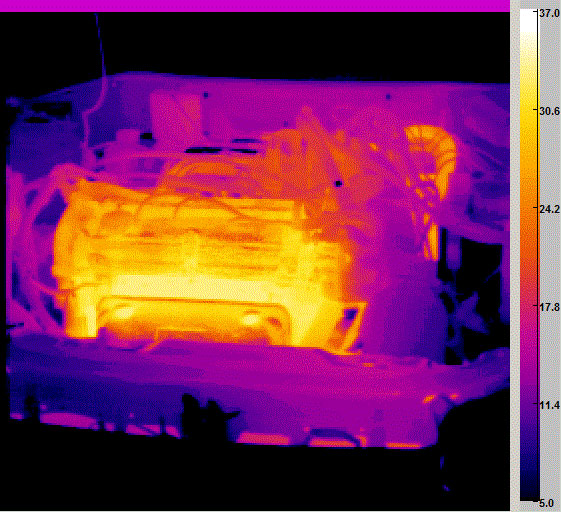
Carnot's work didn't receive much attention during his lifetime, and he died of cholera in 1832, when he was only 36 years old. But others began to realize the importance of his work and built upon it. One of those scientists was Rudolf Clausius, a German physicist who showed that Carnot's principle was not limited to engines, but in fact applied to all systems in which there was a transfer of energy. Clausius' application of an explanation for one phenomenon to many others is also characteristic of science, which assumes that processes are universal.
In 1850, Clausius published a paper in which he developed the second law of thermodynamics, which states that energy always flows from a high energy state (for example, a system that is hot) to a low energy state (one that is cold) (Clausius, 1850). In later work, Clausius coined the term entropy to describe the energy lost from a system when it is transferred, and as an acknowledgement of the pioneering work of Sadi Carnot in providing the foundation for his discoveries, Clausius used the symbol S to refer to the entropy of a system.
But how do engines and entropy relate to the age of the universe? In 1865, Clausius published another paper that restated the Second Law of Thermodynamics as "the entropy of the universe tends to a maximum." If the universe was infinite and existed for all time, the Second Law of Thermodynamics says that all of the energy within the universe would have been lost to entropy by now. In other words, the stars themselves would have burned out long ago, dissipating their heat into surrounding space. The fact that there are still active stars must mean that the universe has existed for a finite amount of time, and was created at some specific point in time. Perhaps the age of that point in time could be determined?
Comprehension Checkpoint
Science assumes that
(A)__natural processes are universal.
(B)__each process is particular to the individual system being observed.
Redshift and the Doppler effect
At about the same time, an Austrian physicist by the name of Christian Doppler was studying astronomy and mathematics. Doppler knew that light behaved like a wave, and so began to think about how the movement of stars might affect the light emitted from those stars. In a paper published in 1842, Doppler proposed that the observed frequency of a wave would depend on the relative speed of the wave's source in relation to the observer, a phenomenon he called a "frequency shift" (Doppler, 1842). He made an analogy to a ship at sail on the ocean, describing how the ship would encounter waves on the surface of the water at a faster rate (and thus higher frequency) if it were sailing into the waves than if it were traveling in the same direction as the waves.
You might be familiar with the frequency shift, which we now call the Doppler Effect in his honor, if you have ever listened to the sound of traffic while standing on the side of the road. The familiar high-to-low pitch change is an example of the effect – the actual frequency of the waves emitted is not changing, but the speed of the passing vehicle affects how quickly those waves reach you. Doppler proposed that we would see the same effect on any stars that were moving: Their color would shift towards the red end of the spectrum if they were moving away from Earth (called a redshift) and towards the blue end of the spectrum if they were moving closer (called a blueshift) (see Figure 4). He expected to be able to see this shift in binary stars, or pairs of stars that orbit around each other. Eventually, Doppler's 1842 paper, entitled "On the coloured light of the double stars and certain other stars of the heavens," would change the very way we look at the universe. However, at the time, telescopes were not sensitive enough to confirm the shift he proposed.
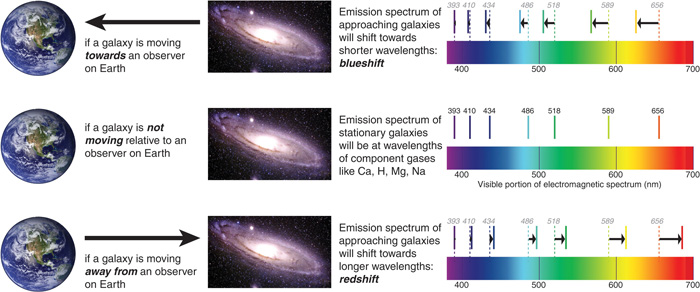
Doppler's ideas became part of the scientific literature and by that means became known to other scientists. By the early 1900s, technology finally caught up with Doppler and more powerful telescopes could be used to test his ideas. In September of 1901, an American named Vesto Slipher had just completed his undergraduate degree in mechanics and astronomy at Indiana University. He got a job as a temporary assistant at the Lowell Observatory in Flagstaff, Arizona, while continuing his graduate work at Indiana. Shortly after his arrival, the observatory obtained a three-prism spectrograph, and Slipher's job was to mount it to the 24-inch telescope at the observatory and learn to use it to study the rotation of the planets in the solar system. After a few months of problems and trouble-shooting, Slipher was able to take spectrograms of Mars, Jupiter, and Saturn. But Slipher's personal research interests were much farther away than the planets of the solar system. Like Doppler, he was interested in studying the spectra of binary stars, and he began to do so in his spare time at the observatory.
Over the next decade, Slipher completed a Master's degree and a PhD at Indiana University, while continuing his work at Lowell Observatory measuring the spectra and Doppler shift of stars. In particular, Slipher focused his attention on stars within spiral nebulae (Figure 5), expecting to find that the shift seen in the spectra of the stars would indicate that the galaxies those stars belonged to were rotating. Indeed, he is credited with determining that galaxies rotate, and was able to determine the velocities at which they rotate. But in 1914, having studied 15 different nebulae, he announced a curious discovery at a meeting of the American Astronomical Society in August:
In the great majority of cases the nebulae are receding; the largest velocities are all positive...The striking preponderance of the positive sign indicates a general fleeing from us or the Milky Way.
Slipher had found that most galaxies showed a redshift in their spectrum, indicating that they were all moving away from us in space, or receding (Slipher, 1915). By measuring the magnitude of the redshift, he was able to determine the recessional velocity or the speed at which objects were "fleeing." Slipher had made an interpretation from his observations that put a new perspective on the universe, and in response, he received a standing ovation for his presentation.

Slipher continued his work with redshift and galaxies and published another paper in 1917, having now examined 25 nebulae and seen a redshift in 21 of them. Georges Lemaître, a Belgian physicist and astronomer, built on Slipher's work while completing his PhD at the Massachusetts Institute of Technology. He extended Slipher's measurements to the entire universe, and calculated mathematically that the universe must be expanding in order to explain Slipher's observation. He published his ideas in a 1927 paper called "A homogeneous Universe of constant mass and growing radius accounting for the radial velocity of extragalactic nebulae" (Lemaître, 1927), but his paper met with widespread criticism from the scientific community. The English astronomer Fred Hoyle ridiculed the work, and coined the term "Big Bang" theory as a disparaging nickname for Lemaître's idea. And none other than Albert Einstein criticized Lemaître, writing to him "Your math is correct, but your physics is abominable" (Deprit, 1984).
Einstein's criticism had a personal and cultural component, two things we often overlook in terms of their influence on science. Several years earlier, Einstein had published his general theory of relativity (Einstein, 1916). In formulating the theory, Einstein had encountered one significant problem: General relativity predicted that the universe had to be either contracting or expanding – it did not allow for a static universe. But a contracting or expanding universe could not be eternal, while a static, non-moving universe could, and the prevailing cultural belief at the time was that the universe was eternal. Einstein was strongly influenced by his cultural surroundings. As a result, he invented a "fudge factor," which he called the cosmological constant, that would allow the theory of general relativity to be consistent with a static universe. But science is not a democracy or plutocracy; it is neither the most common or most popular conclusion that becomes accepted, but rather the conclusion that stands up to the test of evidence over time. Einstein's cosmological constant was being challenged by new evidence.
Comprehension Checkpoint
Scientists are not influenced by their personal experiences, their beliefs, or the culture of which they are a part.
(A)__true
(B)__False
The expanding universe
In 1929, an American astronomer working at the Mt. Wilson Observatory in southern California made an important contribution to the discussion of the nature of the universe. Edwin Hubble had been at Mt. Wilson for 10 years, measuring the distances to galaxies, among other things. In the 1920s, he was working with Milton Humason, a high school dropout and assistant at the observatory. Hubble and Humason plotted the distances they had calculated for 46 different galaxies against Slipher's recession velocity and found a linear relationship (see Figure 6) (Hubble, 1929).
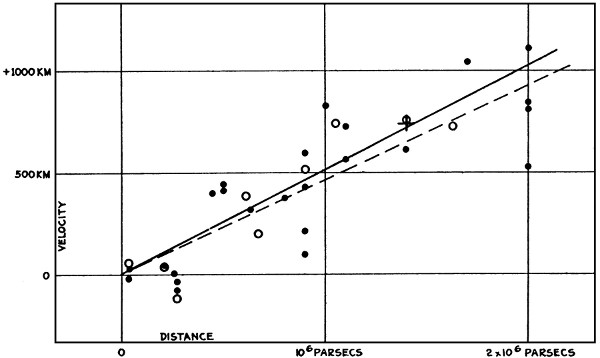
In other words, their graph showed that more distant galaxies were receding faster than closer ones, confirming the idea that the universe was indeed expanding. This relationship, now referred to as Hubble's Law, allowed them to calculate the rate of expansion as a function of distance from the slope of the line in the graph. This rate term is now referred to as the Hubble constant. Hubble's initial value for the expansion rate was 500 km/sec/Megaparsec, or about 160 km/sec per million-light-years.
Knowing the rate at which the universe is expanding, one can calculate the age of the universe by in essence "tracing back" the most distant objects in the universe to their point of origin. Using his initial value for the expansion rate and the measured distance of the galaxies, Hubble and Humason calculated the age of the universe to be approximately 2 billion years. Unfortunately, the calculation was inconsistent with lines of evidence from other investigations. By the time Hubble made his discovery, geologists had used radioactive dating techniques to calculate the age of Earth at about 3 billion years (Rutherford, 1929) – or older than the universe itself! Hubble had followed the process of science, so what was the problem?
Even laws and constants are subject to revision in science. It soon became clear that there was a problem in the way that Hubble had calculated his constant. In the 1940s, a German astronomer named Walter Baade took advantage of the blackouts that were ordered in response to potential attacks during World War II and used the Mt. Wilson Observatory in Arizona to look at several objects that Hubble had interpreted as single stars. With darker surrounding skies, Baade realized that these objects were, in fact, groups of stars, and each was fainter, and thus more distant, than Hubble had calculated. Baade doubled the distance to these objects, and in turn halved the Hubble constant and doubled the age of the universe. In 1953, the American astronomer Allan Sandage, who had studied under Baade, looked in more detail at the brightness of stars and how that varied with distance. Sandage further revised the constant, and his estimate of 75 km/sec/Megaparsec is close to our modern day estimate of the Hubble constant of 72 km/sec/Megaparsec, which places the age of the universe at 12 to 14 billion years old.
The new estimates developed by Baade and Sandage did not negate what Hubble had done (it is still called the Hubble constant, after all), but they revised it based on new knowledge. The lasting knowledge of science is rarely the work of an individual, as building on the work of others is a critical component of the process of science. Hubble's findings would have been limited to some interesting data on the distance to various stars had it not also built on, and incorporated, the work of Slipher. Similarly, Baade and Sandage's contribution were no less significant because they "simply" refined Hubble's earlier work.
Since the 1950s, other means of calculating the age of the universe have been developed. For example, there are now methods for dating the age of the stars, and the oldest stars date to approximately 13.2 billion years ago (Frebel et al., 2007). The Wilkinson Microwave Anisotropy Probe is collecting data on cosmic microwave background radiation (Figure 7). Using these data in conjunction with Einstein's theory of general relativity, scientists have calculated the age of the universe at 13.7 ± 0.2 billion years old (Spergel et al., 2003). The convergence of multiple lines of evidence on a single explanation is what creates the solid foundation of scientific knowledge.
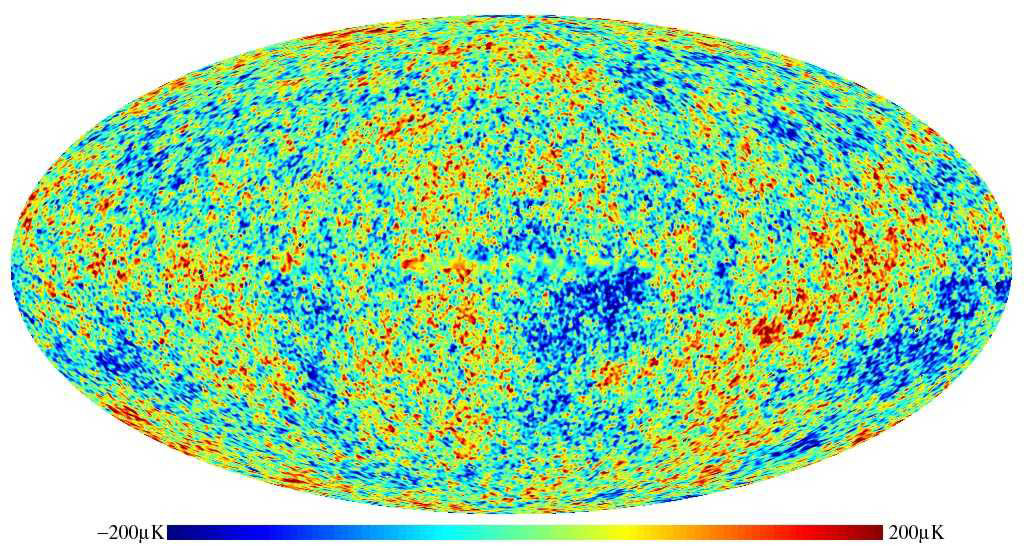
Comprehension Checkpoint
Major ideas in science are rarely the work of
(A)__multiple researchers.
(B)__individuals
Why should we trust science?
Why should we believe what scientists say about the age of the universe? We have no written records of its creation, and no one has been able to "step outside" of the system, as astronauts did when they took pictures of Earth from space, to measure its age. Yet the nature of the scientific process allows us to accurately state the age of the observable universe. These predictions were developed by multiple researchers and tested through multiple research methods. They have been presented to the scientific community through publications and public presentations. And they have been confirmed and verified by many different studies. New studies, or new research methods, may be developed that might possibly cause us to refine our estimate of the age of the universe upward or downward. This is how the process of science works; it is subject to change as more information and new technologies become available. But it is not tenuous – our age estimate may be refined, but the idea of an expanding universe is unlikely to be overturned. As evidence builds to support an idea, our confidence in that idea builds.
Upon seeing Hubble's work, even Albert Einstein changed his opinion of a static universe and called his insertion of the cosmological constant the "biggest blunder" of his professional career. Hubble's discovery actually confirmed Einstein's theory of general relativity, which predicts that the universe must be expanding or contracting. Einstein refused to accept this idea because of his cultural biases. His work had not predicted a static universe, but he assumed this must be the case given what he had grown up believing. When confronted with the data, he recognized that his earlier beliefs were flawed, and came to accept the findings of the science behind the idea. This is a hallmark of science: While an individual's beliefs may be biased by personal experience, the scientific enterprise works to collect data to allow for a more objective conclusion to be identified. Incorrect ideas may be upheld for some amount of time, but eventually the preponderance of evidence helps to lead us to correct these ideas. Once used as a term of disparagement, the "Big Bang" theory is now the leading explanation for the origin of the universe as we know it.
There are other questions we can ask about the origin of the universe, not all of which can be answered by science. Scientists can answer when and how the universe began but cannot calculate the reason why it began, for example. That type of question must be explored through philosophy, religion, and other ways of thinking. The questions that scientists ask must be testable. Scientists have provided answers to testable questions that have helped us calculate the age of the universe, like how distant certain stars are and how fast they are receding from us. Whether or not we can get a definitive answer, we can be confident in the process by which the explanations were developed, allowing us to rely on the knowledge that is produced through the process of science. Someday we may find evidence to help us understand why the universe was created, but for the time being science will limit itself to the last 13.7 or so billion years of phenomena to investigate.
Summary
This module explores the nature of scientific knowledge by asking what science is. It emphasizes the importance of a scientific way of thinking and shows how observation and testing add to the body of scientific knowledge. Focusing on astronomy and physics, the module highlights the work of scientists through history who have contributed to our understanding of the age of the universe as a means of conveying the nature of scientific knowledge.
Key Concepts
- Science consists of a body of knowledge and the process by which that knowledge is developed.
- The core of the process of science is generating testable explanations, and the methods and approaches to generating knowledge are shared publicly so that they can be evaluated by the community of scientists.
- Scientists build on the work of others to create scientific knowledge.
- Scientific knowledge is subject to revision and refinement as new data, or new ways to interpret existing data, are found.
QUIZ
- An important component of the scientific process is that the findings of science are
- We could be certain that the Earth was round only after pictures of the planet were taken from space in 1968.
- How did the Second Law of Thermodynamics contribute to our understanding of the age of the universe?
- Study the line spectra in Section 1 of the image. This spectrum represents the normal emission lines for elements traditionally found in stars (H, He, Ca, Na, etc.). The two sets of line spectra in Section 2 represent the observed spectra for stars SN1 and SN2. What can be said about the movement of these stars based on these spectra?
- Edwin Hubble created the figure below from a combination of his and Vesto Slipher's research data. What does the data in the figure show?
- Einstein incorrectly believed that the universe was static because his theory of relativity predicted a static universe.
- Which of the following statements BEST describes the process by which we have come to understand the age of the universe?
(A)__absolute.
(B)__testable.
(C)__true.
(D)__uncertain.
(A)__true
(B)__false
(A)__It suggested that the universe must be finite in age.
(B)__It suggested that the universe is infinitely old.
(C)__It suggested that the universe must be finite in size.
(D)__It suggested that the universe is contracting.
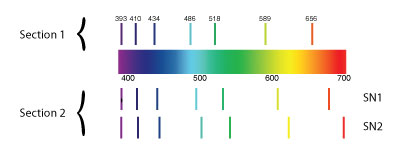
(A)__Both stars are moving toward the observer; however, SN2 is moving faster.
(B)__Both stars are moving toward the observer; however, SN2 is moving slower.
(C)__Both stars are moving away from the observer; however, SN2 is moving faster.
(D)__Both stars are moving away from the observer; however, SN2 is moving slower.
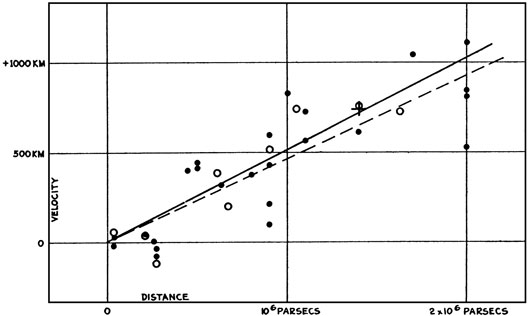
(A)__The stars are receding from one another.
(B)__The universe is expanding.
(C)__The velocity of a star is directly proportional to its distance.
(B)__Star brightness is a function of velocity.
(A)__True
(B)__False
(A)__Scientists have worked independently to test and answer unique questions using only their own data.
(B)__Scientists have identified a single way to measure the age of the universe.
(C)__The age of the universe cannot be known through scientific means.
(D)__Over time, newer studies have built upon, revised, and improved our understanding of the age of the universe.